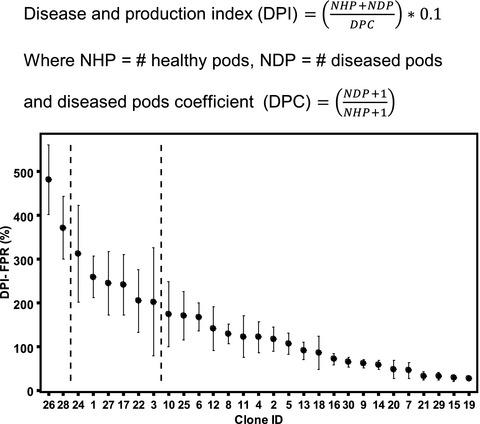当前位置:
X-MOL 学术
›
Plant Pathol.
›
论文详情
Our official English website, www.x-mol.net, welcomes your feedback! (Note: you will need to create a separate account there.)
A disease and production index (DPI) for selection of Cacao (Theobroma cacao L.) clones highly productive and tolerant to pod rot diseases
Plant Pathology ( IF 2.7 ) Pub Date : 2020-05-01 , DOI: 10.1111/ppa.13156 Ramón E. Jaimez 1, 2 , Danilo I. Vera 3 , Argenis Mora 4 , Rey G. Loor 5 , Bryan A. Bailey 6
Plant Pathology ( IF 2.7 ) Pub Date : 2020-05-01 , DOI: 10.1111/ppa.13156 Ramón E. Jaimez 1, 2 , Danilo I. Vera 3 , Argenis Mora 4 , Rey G. Loor 5 , Bryan A. Bailey 6
Affiliation

|
Frosty pod rot (FPR) (Moniliophthora roreri), along with black pod rot (Phytophthora species) and witches’ broom disease (Moniliophthora perniciosa) constitute the main phytosanitary problems limiting cacao (Theobroma cacao) production causing severe yield losses. One of the main sought after methods of pod rot management is the selection of tolerant cacao genotypes. Typically, the selection is carried out through the quantification of the percentage of diseased pods (PDP). However, PDP does not consider the relative productivity, or production potential (PT) of the genotype. Production potential can vary among cacao genotypes. Consequently, genotypes with similar PT can have similar or vastly different disease tolerance levels as measured by PDP. The disease and production index (DPI) was developed to integrate a genotype's tolerance to M. roreri and other diseases as measured by PDP, with its PT. Here, we evaluated the number of healthy pods, number of diseased pods, and weight of fresh seed for 29 clones grown in replicated five‐tree plots over 4 years. The data obtained was used to calculate PDP and DPI for each clone for three different disease combinations: frosty pod rot alone, pod rots other than frosty pod rot, and the combination of all pod rots. Multivariate analysis verified that DPI discriminated between clones based on productivity and disease tolerance. Surprisingly, there was a close ranking of clones between resistance to FPR and resistance to all other pod rots. The DPI can be used in breeding programmes focused on the selection of high yielding disease‐tolerant cacao genotypes.
中文翻译:

用于选择高产且对豆荚腐烂病具有耐受性的可可 (Theobroma cacao L.) 无性系的疾病和生产指数 (DPI)
霜荚腐病 (FPR) (Moniliophthora roreri) 以及黑荚腐病 (Phytophthora 种) 和女巫笤帚病 (Moniliophthora perniciosa) 构成限制可可 (Theobroma cacao) 生产的主要植物检疫问题,造成严重的产量损失。豆荚腐烂管理的主要方法之一是选择耐受性可可基因型。通常,选择是通过量化患病豆荚 (PDP) 的百分比来进行的。但是,PDP 不考虑基因型的相对生产力或生产潜力 (PT)。不同可可基因型的生产潜力可能不同。因此,通过 PDP 测量,具有相似 PT 的基因型可以具有相似或截然不同的疾病耐受水平。疾病和生产指数 (DPI) 旨在整合基因型对 M. 的耐受性。roreri 和其他疾病,由 PDP 及其 PT 测量。在这里,我们评估了 4 年内在重复的五棵树地块中生长的 29 个克隆的健康豆荚数、患病豆荚数和新鲜种子的重量。获得的数据用于计算三种不同疾病组合的每个克隆的 PDP 和 DPI:单独的霜状荚腐病、除霜状荚果腐烂以外的荚果腐烂病和所有荚果腐烂病的组合。多变量分析证实 DPI 根据生产力和疾病耐受性区分克隆。令人惊讶的是,在对 FPR 的抗性和对所有其他豆荚腐烂的抗性之间,克隆的排名很接近。DPI 可用于专注于选择高产抗病可可基因型的育种计划。我们评估了 4 年内在重复的五棵树地块中生长的 29 个克隆的健康豆荚数、患病豆荚数和新鲜种子重量。获得的数据用于计算三种不同疾病组合的每个克隆的 PDP 和 DPI:单独的霜状荚腐病、除霜状荚果腐烂以外的荚果腐烂病和所有荚果腐烂病的组合。多变量分析证实 DPI 根据生产力和疾病耐受性区分克隆。令人惊讶的是,在对 FPR 的抗性和对所有其他豆荚腐烂的抗性之间,克隆的排名很接近。DPI 可用于专注于选择高产抗病可可基因型的育种计划。我们评估了 4 年内在重复的五棵树地块中生长的 29 个克隆的健康豆荚数、患病豆荚数和新鲜种子重量。获得的数据用于计算三种不同疾病组合的每个克隆的 PDP 和 DPI:单独的霜状荚腐病、除霜状荚果腐烂以外的荚果腐烂病和所有荚果腐烂病的组合。多变量分析证实 DPI 根据生产力和疾病耐受性区分克隆。令人惊讶的是,在对 FPR 的抗性和对所有其他豆荚腐烂的抗性之间,克隆的排名很接近。DPI 可用于专注于选择高产抗病可可基因型的育种计划。获得的数据用于计算三种不同疾病组合的每个克隆的 PDP 和 DPI:单独的霜状荚腐病、除霜状荚果腐烂以外的荚果腐烂病和所有荚果腐烂病的组合。多变量分析证实 DPI 根据生产力和疾病耐受性区分克隆。令人惊讶的是,在对 FPR 的抗性和对所有其他豆荚腐烂的抗性之间,克隆的排名很接近。DPI 可用于专注于选择高产抗病可可基因型的育种计划。获得的数据用于计算每个克隆对于三种不同疾病组合的 PDP 和 DPI:单独的霜状荚腐病、除霜状荚果腐烂以外的荚果腐烂病和所有荚果腐烂病的组合。多变量分析证实 DPI 根据生产力和疾病耐受性区分克隆。令人惊讶的是,在对 FPR 的抗性和对所有其他豆荚腐烂的抗性之间,克隆的排名很接近。DPI 可用于专注于选择高产抗病可可基因型的育种计划。在对 FPR 的抗性和对所有其他豆荚腐烂的抗性之间,克隆的排名很接近。DPI 可用于专注于选择高产抗病可可基因型的育种计划。在对 FPR 的抗性和对所有其他豆荚腐烂的抗性之间,克隆的排名很接近。DPI 可用于专注于选择高产抗病可可基因型的育种计划。
更新日期:2020-05-01
中文翻译:

用于选择高产且对豆荚腐烂病具有耐受性的可可 (Theobroma cacao L.) 无性系的疾病和生产指数 (DPI)
霜荚腐病 (FPR) (Moniliophthora roreri) 以及黑荚腐病 (Phytophthora 种) 和女巫笤帚病 (Moniliophthora perniciosa) 构成限制可可 (Theobroma cacao) 生产的主要植物检疫问题,造成严重的产量损失。豆荚腐烂管理的主要方法之一是选择耐受性可可基因型。通常,选择是通过量化患病豆荚 (PDP) 的百分比来进行的。但是,PDP 不考虑基因型的相对生产力或生产潜力 (PT)。不同可可基因型的生产潜力可能不同。因此,通过 PDP 测量,具有相似 PT 的基因型可以具有相似或截然不同的疾病耐受水平。疾病和生产指数 (DPI) 旨在整合基因型对 M. 的耐受性。roreri 和其他疾病,由 PDP 及其 PT 测量。在这里,我们评估了 4 年内在重复的五棵树地块中生长的 29 个克隆的健康豆荚数、患病豆荚数和新鲜种子的重量。获得的数据用于计算三种不同疾病组合的每个克隆的 PDP 和 DPI:单独的霜状荚腐病、除霜状荚果腐烂以外的荚果腐烂病和所有荚果腐烂病的组合。多变量分析证实 DPI 根据生产力和疾病耐受性区分克隆。令人惊讶的是,在对 FPR 的抗性和对所有其他豆荚腐烂的抗性之间,克隆的排名很接近。DPI 可用于专注于选择高产抗病可可基因型的育种计划。我们评估了 4 年内在重复的五棵树地块中生长的 29 个克隆的健康豆荚数、患病豆荚数和新鲜种子重量。获得的数据用于计算三种不同疾病组合的每个克隆的 PDP 和 DPI:单独的霜状荚腐病、除霜状荚果腐烂以外的荚果腐烂病和所有荚果腐烂病的组合。多变量分析证实 DPI 根据生产力和疾病耐受性区分克隆。令人惊讶的是,在对 FPR 的抗性和对所有其他豆荚腐烂的抗性之间,克隆的排名很接近。DPI 可用于专注于选择高产抗病可可基因型的育种计划。我们评估了 4 年内在重复的五棵树地块中生长的 29 个克隆的健康豆荚数、患病豆荚数和新鲜种子重量。获得的数据用于计算三种不同疾病组合的每个克隆的 PDP 和 DPI:单独的霜状荚腐病、除霜状荚果腐烂以外的荚果腐烂病和所有荚果腐烂病的组合。多变量分析证实 DPI 根据生产力和疾病耐受性区分克隆。令人惊讶的是,在对 FPR 的抗性和对所有其他豆荚腐烂的抗性之间,克隆的排名很接近。DPI 可用于专注于选择高产抗病可可基因型的育种计划。获得的数据用于计算三种不同疾病组合的每个克隆的 PDP 和 DPI:单独的霜状荚腐病、除霜状荚果腐烂以外的荚果腐烂病和所有荚果腐烂病的组合。多变量分析证实 DPI 根据生产力和疾病耐受性区分克隆。令人惊讶的是,在对 FPR 的抗性和对所有其他豆荚腐烂的抗性之间,克隆的排名很接近。DPI 可用于专注于选择高产抗病可可基因型的育种计划。获得的数据用于计算每个克隆对于三种不同疾病组合的 PDP 和 DPI:单独的霜状荚腐病、除霜状荚果腐烂以外的荚果腐烂病和所有荚果腐烂病的组合。多变量分析证实 DPI 根据生产力和疾病耐受性区分克隆。令人惊讶的是,在对 FPR 的抗性和对所有其他豆荚腐烂的抗性之间,克隆的排名很接近。DPI 可用于专注于选择高产抗病可可基因型的育种计划。在对 FPR 的抗性和对所有其他豆荚腐烂的抗性之间,克隆的排名很接近。DPI 可用于专注于选择高产抗病可可基因型的育种计划。在对 FPR 的抗性和对所有其他豆荚腐烂的抗性之间,克隆的排名很接近。DPI 可用于专注于选择高产抗病可可基因型的育种计划。



























 京公网安备 11010802027423号
京公网安备 11010802027423号